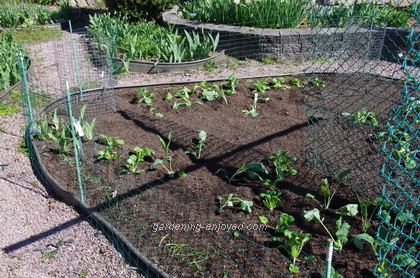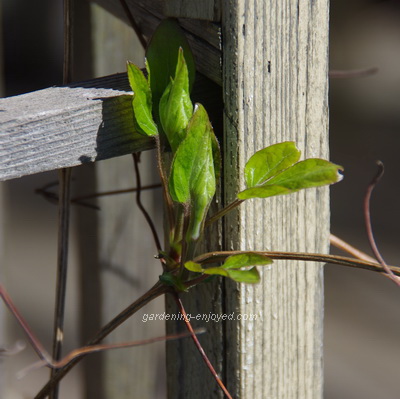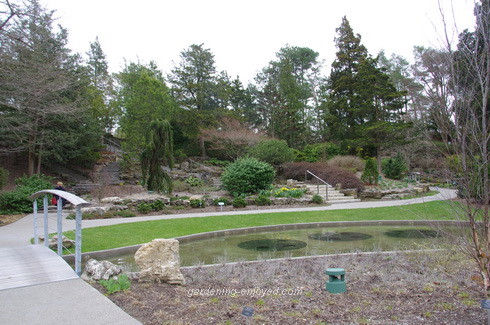| Back to Back Issues Page |
 |
|
Dallying In The Dirt, Issue #257--- The Royal Botanical Garden renews its rock garden. May 05, 2016 |
Even as life seems to be ridiculously busy, as busy as a gardener in spring, there sometimes, is one of those busy items that is a break from the normal nuttiness and is a delight. That happened last Friday. We were invited to the grand reopening of the Royal Botanical Garden’s famous Rock Garden. That garden is one of my earliest memories of being impressed by a garden visit. The garden is 80 years old and was certainly due for an upgrade and they have done an admirable job of retaining enough of the old garden while adding a thoroughly modern renovation. This was not a small project in size or in difficulty. $20 million dollars was required to complete it and $7 million was raised from private donations and the remainder was, for me, some of the best spent tax dollars by the federal and provincial governments. The old garden relied very heavily on spring flowering bulbs and some have been retained but a much larger emphasis has been placed on a succession of perennials to make the garden equally impressive at many more times of year. The inclusion of water features and significant lighting will keep this garden busy well into the evening. The new modern reception building will combine with the garden to make this one of the premier sites for weddings and meetings. I will be back many times to watch this garden evolve over the entire gardening season.  Most of the early vegetables have been planted and the rabbit fence has been erected around that portion of the garden. I was under some pressure to finish this little chore. The Peas and Lettuce had been planted last week and I knew the rabbits would mow them down the minute they germinated. The Pak Choi, Broccoli, Cabbage and Cauliflower needed to be planted in that bed and the Onions needed to be planted all around its edge. They are easy to plant and maintain in that location. The problem is planting them must be done before the fence goes up or else that planting becomes a much more difficult job. There always seems to be a chain of events that forces me to do three jobs before I can finish the first one. All of the transplants grew well this year and that garden now looks great and I
anticipate eating the Pak Choi in a couple of weeks. It’s always satisfying to stand back and look at a well completed job. Then you look over your shoulder at the next chore that is impatiently waiting for your attention. That’s gardening in the spring.
Most of the early vegetables have been planted and the rabbit fence has been erected around that portion of the garden. I was under some pressure to finish this little chore. The Peas and Lettuce had been planted last week and I knew the rabbits would mow them down the minute they germinated. The Pak Choi, Broccoli, Cabbage and Cauliflower needed to be planted in that bed and the Onions needed to be planted all around its edge. They are easy to plant and maintain in that location. The problem is planting them must be done before the fence goes up or else that planting becomes a much more difficult job. There always seems to be a chain of events that forces me to do three jobs before I can finish the first one. All of the transplants grew well this year and that garden now looks great and I
anticipate eating the Pak Choi in a couple of weeks. It’s always satisfying to stand back and look at a well completed job. Then you look over your shoulder at the next chore that is impatiently waiting for your attention. That’s gardening in the spring. Suddenly as spring arrives with amazing speed new buds appear on Clematis, Hydrangeas, Roses and several other woody plants that will now require pruning. There are books written on how to prune Clematis and I manage to ignore most of them. In a climate different from ours some of those rules apply but I’m just happy when the vines survive the winter and then I prune them back to a healthy pair of buds and let them grow. There are a couple of rampantly growing Clematis that bloom on the current years growth and they get pruned to a couple of buds as close to the soil as possible. Some of my Clematis have become quite a tangle of vines and at this time of year I will take an hour and start to remove many of those vines and choose a few that I can easily train up their trellises and then prune them at various heights to create as large and expansive display of bloom as possible. Next the Hydrangeas which are
just starting to open their buds. It’s a crazy but wonderful time of year to be a gardener.
Suddenly as spring arrives with amazing speed new buds appear on Clematis, Hydrangeas, Roses and several other woody plants that will now require pruning. There are books written on how to prune Clematis and I manage to ignore most of them. In a climate different from ours some of those rules apply but I’m just happy when the vines survive the winter and then I prune them back to a healthy pair of buds and let them grow. There are a couple of rampantly growing Clematis that bloom on the current years growth and they get pruned to a couple of buds as close to the soil as possible. Some of my Clematis have become quite a tangle of vines and at this time of year I will take an hour and start to remove many of those vines and choose a few that I can easily train up their trellises and then prune them at various heights to create as large and expansive display of bloom as possible. Next the Hydrangeas which are
just starting to open their buds. It’s a crazy but wonderful time of year to be a gardener.Now it’s time to answer a few of my reader’s questions. Don’t forget to check the front page of the Website for frequent short ideas for current gardening activities. Teresa Asks? I have a small vegetable garden that is shadowed be a cedars hedge I planted 30 years ago. I've asked a few horticulturalists at various nurseries what to do with them after I severely pruned one side of them. It's been 2 years and nothing has grown back on the one side. I'm thinking of cutting back to the main stem and using the cedars as a structure for an Issai Kiwi vine. I was hoping to get more light on the garden by reducing the height of the hedge and maintain a bit of privacy in the summer with the vine. |
| Back to Back Issues Page |
